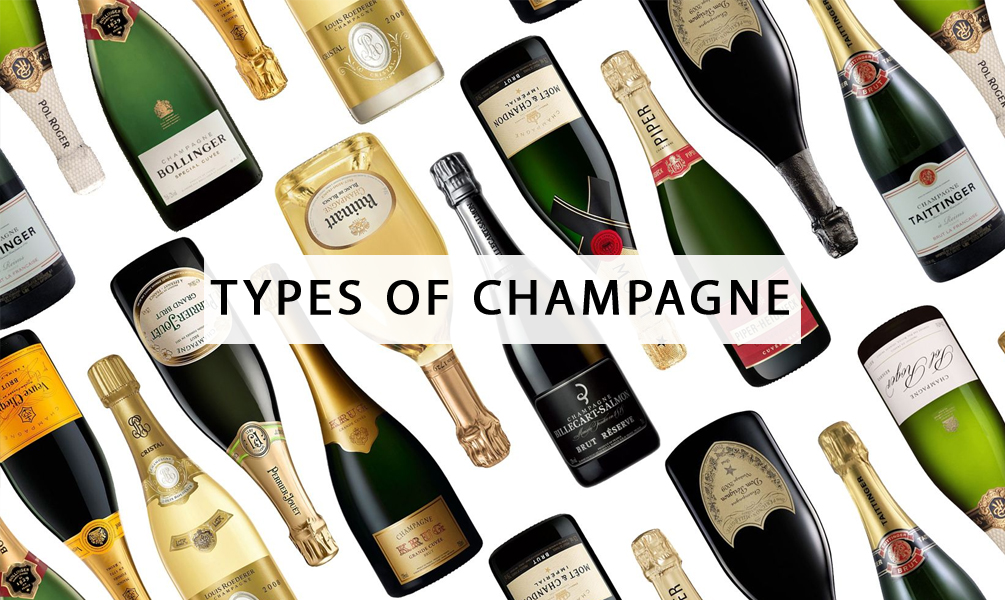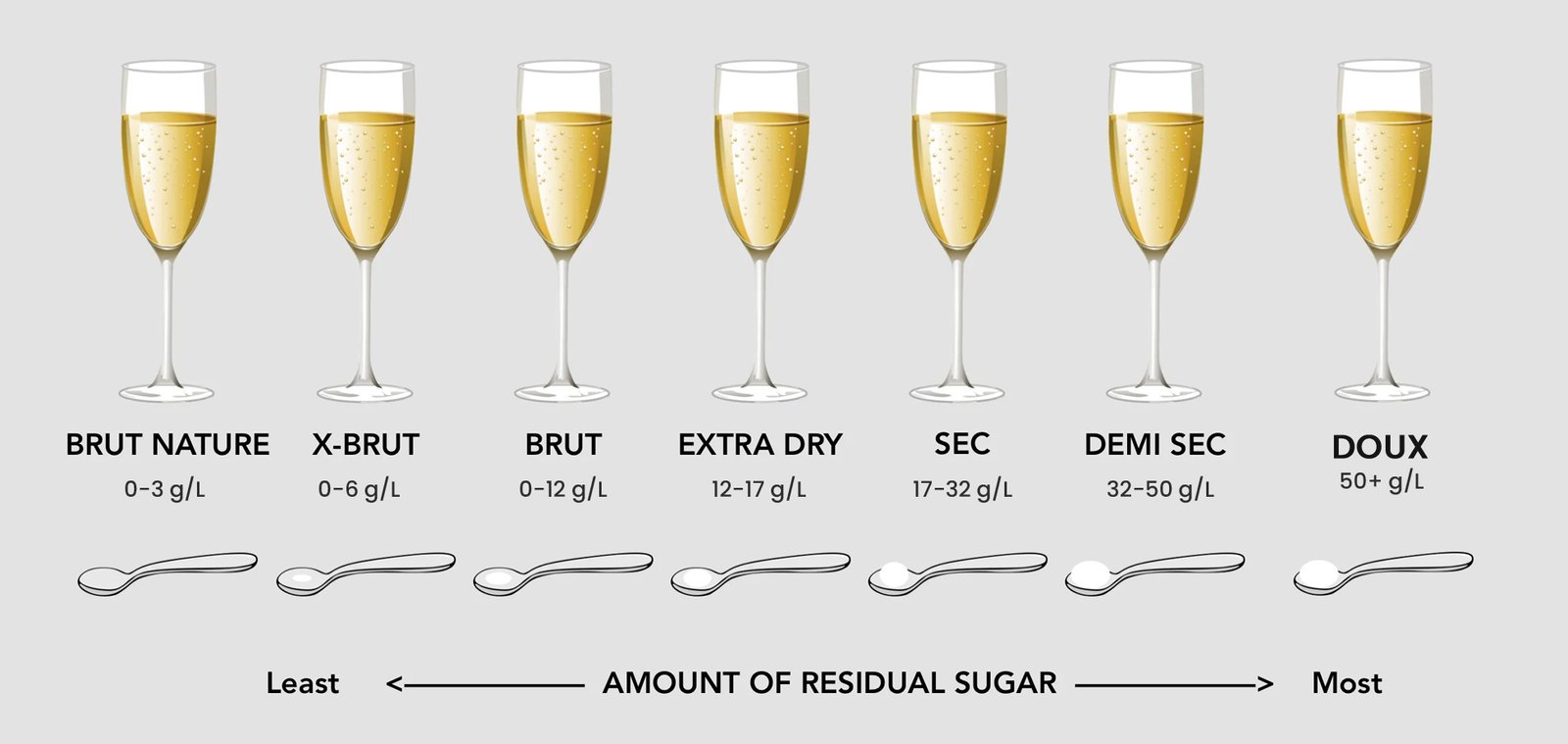
The bubbly and sparkly drink is the life of any celebration. Popping out a bottle of champagne adds charm and elegance to parties. Champagne is one of the kinds of sparkling wines that originated mainly from the Champagne region of France. For the production of Champagne, wine undergoes a second fermentation process where yeast and sugar are added to a base wine and sealed; it forms CO2 and dissolves in the wine, creating bubbles. This technique is labelled as a traditional method (or Méthode traditionnelle).
These luxurious and toasty beverages come in a wide range of varieties. You may choose a bottle of champagne to grace your event or any occasion as per your taste and preference. The types of champagne are determined by different factors, including the grapes used and the champagne ABV (alcohol by volume), which can help you identify the characteristics and style of the champagne.
Let’s explore the extensive world of champagne to get acquainted with the drink and have a lifetime experience of the renowned French sparkling wine.
On The Basis Of Grape Variety
To begin with, the variety of the grapes is the crucial factor for producing a good-quality bottle of champagne. There are mostly three types of grapes that are used in making champagne. Chardonnay, Pinot Noir, and Pinot Meunier are the core grape varietals that are perfectly blended to achieve the unique taste of the drink, often found in high-end champagne.
- Chardonnay: Chardonnay is the primary white grape variety that is used in producing outstanding-quality champagne, well-known for its fruity aromas, high acidity, freshness, and elegant flavours of floral and citrus fruits. It is primarily grown in the region of Côte des Blancs, adding wonderful freshness and refinement to the drink.
- Pinot Noir: Pinot Noir is a black grape variety with fruity and refreshing flavours. This grape varietal is often used in the production of Rosé champagnes due to its red-fruit flavors. It is well-suited to chalky soil and cool weather, adding richness, structure, and complexity to flavors in champagne.
- Pinot Meunier: This is the third primary grape varietal that is being used in champagne-making, mainly of black color and well-known for its roundness, refreshing flavors of fruits, and floral aromas. It is a more approachable style of champagne due to its extreme compatibility with chalky soils.
On The Basis Of Sweetness
The sweetness of the champagne is determined by the dosage of sugar added to it during the making process. The dosage is a solution of sugar and wine added to enhance the sweetness of the drink, known as liqueur d’expédition. There are different types of champagne that vary in sweetness level, ranging from bone-dry to deliciously sweet and it's interesting to note that the level of sweetness can influence the calorie content in each bottle. If you're curious about the specifics, check out our blog on how many calories in a champagne bottle to learn more about how different sweetness levels affect it.

| Sweetness Level | Dosage | Sugar Spectrum | Best Paired with... | Popular types of Champagne |
|---|---|---|---|---|
| Brut Nature | Zero Sugar Added | Bone-Dry Style | Seafoods, Meats, Light Cheese and Canapes | 2OO6 Pommery Cuvee Louise Brut Nature Champagne |
| Extra Brut | Less Than 6G/L | Too dry to notice Sweetness | Seafood, Salty Foods, and cured meats | Champagne Brisson Lahaye—La Distinguée |
| Brut | Less Than 12g/L | Fairly dry wine, slightly sweet | Less sweet foods, mature cheese, salty and fried dishes | Veuve Clicquot Brut Champagne, Billecart Salmon Brut Champagne |
| Extra Dry | Less than 17g/L | Medium-dry style/ slightly sweeter | Spicy Mexican and Thai Dishes, blue cheese, shellfish and grilled meats | Pol Roger Extra Dry Champagne, Virginie T Special Macaron Extra Dry Millesime, Champagne, France |
| Sec | Less than 32g/L | Medium-Sweet | Fruit Tarts, Aged Cheese | Taittinger Nocturne Sec Champagne |
| Demi-Sec | Less than 50g/L | Relatively Sweet | Desserts and Chocolates, Fruit Tarts | Beau Joie Demi Sec Sugar King Champagne |
| Doux | More than 50g/L | Sweetest one | Rich Desserts | Veuve Clicquot Rich |
Main Styles Of Champagne
The crisp and bubbly beverage is also classified into different styles as per its production method and technique. Because different varieties of grapes are used to make each Champagne, there are variations in blends and styles due to which Champagne gets a distinct flavor profile and also addition of new elements to it. Understanding the grapes used in the production process will enable you to choose a Champagne that suits the needed palate and make an informed decision.
- Blanc De Blancs Champagne: Blanc De Blancs champagne is a unique champagne that is made exclusively with 100% Chardonnay. The term "White from White," or "Blanc de Blancs," denotes that the white grapes used to produce these Champagnes are cultivated in the Côte de Blanc region of Champagne, France. The wine is produced using the Traditional method where the grapes are slightly pressed to extract the juice making sure there is no contact keeping the Champagne fresh and light. Recognised for its green and lemon yellow appearance, these Champagnes smell strongly of white flowers, lime blossoms, rose, and violet, along with a gritty minerality. It has a pleasant acidity on the palate with citrus aromas and an acidity that highlights the vibrancy. The drink is light and delicate in personality; its citrusy flavour, fruity aroma, and mineral notes make it popular among Champagne drinkers. Delamotte Blanc de Blancs is one of the most popular types of champagne in this style.
- Blanc de Noir Champagne: A mix of two grape varietals, Pinot Noir and/or Pinot Meunier, is called Blanc de Noir. This champagne has a unique blend of complexity and finesse, enriched with red fruit flavours and velvety texture. During this procedure, the grapes are squeezed to release the juice. Skin contact must be carefully considered, since excessive contact may result in over extraction of color. This process ensures the Champagne has a rich and full bodied texture. On the palate Blanc de Noir appears to have notes of berries with a full mouthfeel. Veuve Clicquot Blanc de Noirs is a go-to choice of this style.
- Rosé Champagne: The blush pink color of the Rosé champagne comes by precisely blending red and white wine or by macerating red-skinned grapes. Pinot Noir and Pinot Meunier are the grape varieties that are used in the red wine. These grapes are crushed and left in contact with the skin inorder to achieve the pink color. White wine is made up of Chardonnay grapes; both these wines are then blended together and some amount of sugar and yeast is added in it for second fermentation to take place which leads to formation of the bubbles giving it a lingering effervescence when tasted. The Champagne has notes of berries, strawberries and cherries giving it a vibrant feel.Dom Perignon Rosé champagne is one of the best types of champagne in Rosé style; its elegant and delightful drink has red fruit flavours and floral aromas to set the perfect environment for a romantic date night.
- Prestige Cuvee: The Prestige Cuvee champagne is made with the highest quality grape varietals from the best vineyards. Prestige cuvees are the pinnacle of champagne styles, showcasing the finest quality, luxury, complexity, and refinement. Uncork a bottle of Taittinger Cuvee Prestige Rose to get the taste of Prestige Cuvee champagne.
- Organic Champagne: These are the champagnes that are made with organic grapes, free from synthetic pesticides, chemicals, and fertilizers using the traditional methods. The drink has fruity aromas and delicate flavours paired best with seafood and vegetables. Philippe Lancelot Les Hauts d'Epernay 2018 is one of the best types of champagne amongst organic champagnes.
On The Basis Of Ageing
The best types of champagne are perfectly aged to develop a certain depth and complexity in the champagne. The aging process affects the aroma, texture, and taste of the drink and makes it more valuable.
- Vintage Champagne: Vintage Champagne is made with single-year-harvested grapes, reflecting the craftsmanship of a winemaker of that particular year. As per law, a bottle is aged for a minimum of 3 years before release. Each vintage champagne is unique due to its taste, aroma, and character. There are different kinds of champagne that are vintage, and Boizel Grand Vintage 2007 is one of them.
- Non-Vintage Champagne: The non-vintage champagne is made by blending multiple vintages of different years to create a standardized taste and house style. The champagne is versatile and harmonious with acidic, mineral, and fruity flavours. Veuve Clicquot Non-Vintage champagne is an ultimate choice of this style.
- Reserved Champagne: Reserved champagne is often referred to as reserve wines that are specifically reserved to blend with future vintage wines. It is a premium-quality beverage that is separately aged and kept for several years to enhance the complexity, depth, and character of the champagne.
On The Basis Of Terroir
Lastly, the different kinds of champagne are classified according to the region of France; mainly, there are four areas, or crus, and they are Côte des Bar, Côte des Blanc, Montage des Reims, Vallée de la Marne and Côte de Sezanne.. The classification of these areas is based on the soil quality, climatic conditions, historical significance, and reputation of the vineyard.
- Grand Cru: Grand Cru are the best vineyards producing the highest quality grapes for the finest champagnes. These vineyards are considered highest in classification and have top-quality soil, climate conditions, and historical relevance. Of the 317 vines harvested in towns and villages, only 17 are classified as Grand Cru. Because of the superb terroir—which is made up of elements like soil type, climate, and flora that grow near the vineyards—the popular Champagnes produced from these vineyards are regarded as exceptional, satisfying all requirements in taste and aroma. Examples of some good types of champagne from Grand Cru are Pommery Grand Cru Royal Champagne and Billecart-Salmon Brut Blanc de Blancs Grand Cru Champagne.
- Premier Cru: The second best in classification is Premier Cru, producing high-quality grapes. The terroir of these vineyards is exceptionally good, along with great historical significance and a decent reputation, resulting in high-quality champagnes. Premier Cru is a French term meaning “ First Growth” represents the excellent terroir of the vineyard. This is the second best appellation given to the 44 vineyards out of 319. What could be the possible difference between Grand Cru and Premier Cru? The simple differentiating factor is that the Champagnes labeled as Grand Cru are simply considered the best while the ones designated as Premier Cru are made from high quality grapes that eventually leads to high quality Champagne. Some of the finest bubbles come from this terroir, and Paul Goerg Premier Cru Brut Champagne is one of them.
- Autre Cru: Autre Cru falls under lowest in the classification, meaning alternative vineyards other than flagship vineyards. It also produces good-quality grapes, but not as good as Grand Cru or Premier Cru vineyards. Autre Cru falls under the lowest classification, meaning alternative vineyards other than flagship vineyards. It also produces good-quality grapes, but not as good as Grand Cru or Premier Cru vineyards.
Additionally, alcohol by volume is also considered a factor for the classification of Champagne. Alcohol by volume, or ABV, is the standard measure of alcohol contained in an alcoholic beverage; it affects the structure, intensity, and overall drinking experience. Mostly, champagnes have an ABV of 11% to 13%, and it is considered a standard ABV. Brut, Extra-Dry, and Demi-Sec fall under the same category. Some light sparkling wines, such as Prosecco, have 11-11.5% ABV, which is considered lower ABV. The drinks that have an ABV of 12.5-13% are higher ABV drinks; vintage champagnes and prestige cuvées fall under this category. To learn more about the ABV, read our blog How Much Alcohol in Champagne.
Price Range Of Champagne
If you are new to the world of Champagne then the obvious question that comes to mind is, “How much does a bottle of the best Champagne cost?”
Everyone has a specific budget in mind and wants a popular Champagne that is both delicious and of the highest caliber. Champagne, meanwhile, can cost anywhere from a few hundred to several thousand dollars. It is crucial to remember that the price of Champagne can vary depending on a number of aspects, including the type of Champagne, its manufacturing process, harvesting technique, region, bottle size, and so on.
If you are looking for a best champagne under $100 then you can consider Pommery Grand Cru Royal Champagne or Louis Roederer Collection 243 Champagne, considered to be best options at pocket friendly price.
If you are looking for a best expensive Champagne then choosing 2004 Krug "Clos du Mesnil" Brut Blanc de Blancs Champagne or Dom Perignon P2 – Plenitude 2 Champagne would be considered an excellent move.
Conclusion
Now that the enigma of the many different types of Champagne styles has been solved, it is up to you to decide how you will choose your champagne. If your sweet tooth and beginner in Champagne journey then choosing the best champagne based on its sweetness level is ideal or are you someone who opts for luxury in life then guess what you might be picking a bottle of vintage. if you are someone who appreciates a Champagne that is delicious and leaves your taste palate in awe then comprehending the kind of grape variety used in the Champagne might be worth your use.
Each bottle of bubbly has its own uniqueness and tells a story of its craftsmanship. At Wine & Champagne Gifts, we offer a diverse selection of champagne and champagne gift baskets, making us your one-stop shop for all your gifting and celebratory needs. From high-end champagnes to regular ones, we offer everything you need to make your moments extraordinary. Visit our website and discover endless enjoyment with a bottle of crisp, sparkly, and bubbly champagne!























Leave a Comment